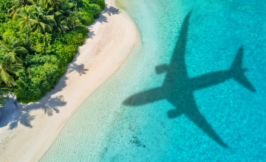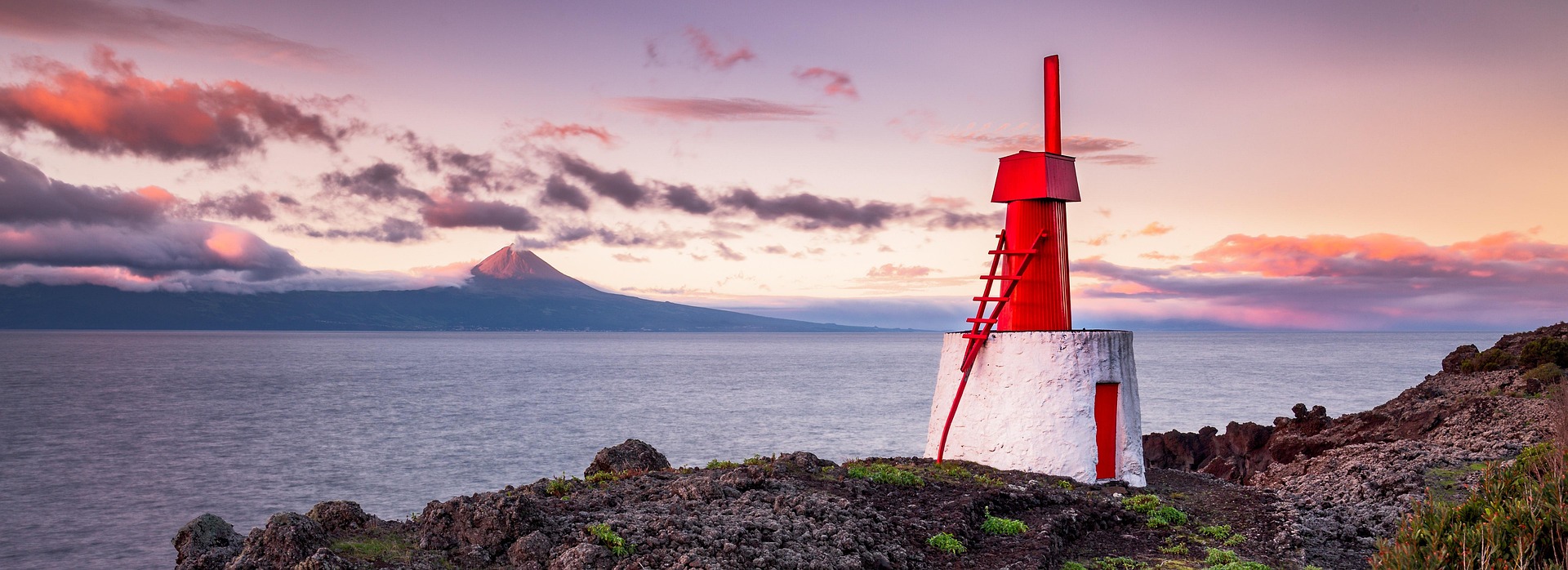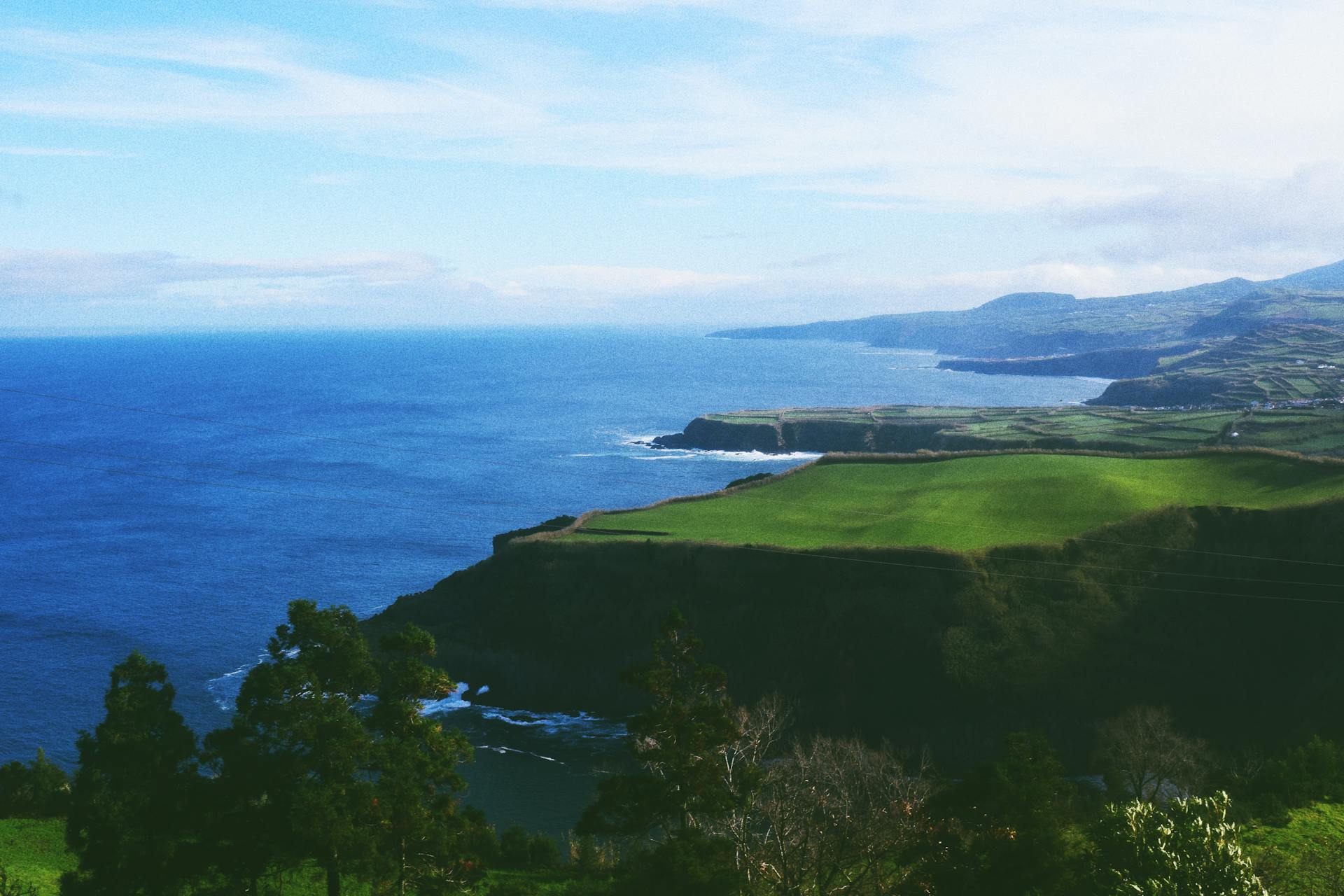Travel Consultants
Is your time too precious to spend long hours searching for the perfect holiday in the Azores? Looking for expert help in organizing your trip? Hire an Azores.com Travel consultant.


With their dramatic volcanic landscapes, thermal pools, and pristine Atlantic beaches, the Azores islands offer you a European adventure unlike any other. Located midway between North America and mainland Portugal, this autonomous archipelago combines raw natural beauty with authentic Portuguese culture, making it a top destination for an Azores vacation.
Your journey to these nine distinct islands is now easier than ever, with direct flights from Boston and New York to São Miguel, the largest island. From whale watching in Faial to climbing Mount Pico, Portugal’s highest peak, to soaking in Terra Nostra’s iron-rich thermal pools, you’ll discover why these islands are Europe’s best-kept secret.
In this ultra-complete Azores travel guide, you will learn everything you need to know about your trip.
Key Takeaways:

Azores, Portugal’s autonomous archipelago in the mid-Atlantic, consists of nine volcanic islands spread across three groups. Located about 1,500 km from mainland Europe, these islands showcase a unique blend of Portuguese heritage and distinct island culture. The archipelago’s strategic position has historically made it an important stopping point for trans-Atlantic travel, shaping its development and international connections.

Image: Pawel Kalisinski
With direct flights from Boston and New York making access easier than ever, the Azores offer you an unspoiled European destination without the crowds. These islands combine dramatic landscapes, thermal pools, world-class hiking, and authentic Portuguese culture, all while maintaining their pristine natural state – 10% of the territory is protected as nature reserves.
In fact, you’ll discover that each island presents its own distinct appeal: São Miguel’s famous hot springs and crater lakes, Pico’s UNESCO-listed vineyards and Portugal’s highest peak (2,351m), and Terceira’s rich historical sites. The archipelago’s commitment to sustainable tourism means you can enjoy whale watching, hiking, and thermal bathing while supporting local conservation efforts.
Islands throughout the Azores showcase distinctive characteristics that set them apart from typical European destinations. You’ll find black sand beaches formed by volcanic activity, crater lakes in vivid shades of green and blue, and fields divided by ancient stone walls built from lava rock. The archipelago’s volcanic origin has created a landscape unlike anything you’ll see elsewhere in Europe.
A year-round mild climate, with temperatures ranging from 16°C (61°F) in winter to 25°C (77°F) in summer, allows you to explore these natural wonders in any season. Your outdoor adventures are enhanced by the islands’ unique microclimate, which supports both European and tropical vegetation, creating diverse ecosystems where you can spot rare species like the Azorean Bullfinch and various endemic plants.
To reach the Azores from the United States, you can choose from direct flights departing from Boston (BOS) and New York (JFK) to Ponta Delgada (PDL) on São Miguel Island. Flight time is approximately 5 hours from the East Coast. If you’re traveling from other U.S. cities, you’ll need to connect through these hubs or consider European connections through Lisbon or Porto.
Flight options to the Azores are primarily served by Azores Airlines (SATA) and TAP Air Portugal. Your main gateway will be João Paulo II Airport (PDL) in Ponta Delgada, which handles 65% of all air traffic to the archipelago. During peak season (June-September), you’ll find increased frequency of direct flights from the U.S.
But if you’re looking to explore beyond São Miguel, you should know that inter-island flights are operated exclusively by SATA Air Açores. The airline maintains regular connections between all nine islands, with more frequent service to the central group (Terceira, Faial, and Pico) and São Miguel, making travel easy for your Azores vacation. Booking these flights in advance is necessary, especially during summer months when seats fill quickly.
Among the entry requirements, U.S. citizens need a valid passport with at least six months validity beyond your planned stay. As the Azores are part of Portugal, and thus the European Union, you can stay visa-free for up to 90 days within a 180-day period.
Options for clearing customs at PDL airport are straightforward and typically quick. You’ll find two lanes: one for EU citizens and another for non-EU travelers. The immigration hall features modern automated gates for EU passports, while U.S. passport holders proceed to manned booths. Your checked luggage usually arrives promptly, with average processing times of 30-45 minutes from landing to exit.

Image: Gabriela Mendes, Ponta Delgada, Azores, Portugal
Along with its volcanic landscapes, the Azores features a mild year-round climate with temperatures ranging from 16°C (61°F) in winter to 25°C (77°F) in summer. You’ll experience quick weather changes throughout the day, with locals often saying you can get “four seasons in one day.” The archipelago sees more rainfall from November to April, while May through October offers more stable conditions for outdoor activities.
With summer (June to September) marking the high season, you’ll find the islands at their busiest and most expensive during these months, which is an important consideration for your trip to the Azores. The shoulder seasons of April-May and October-November offer an excellent balance of good weather and fewer tourists.
Indeed, your choice of season can significantly impact your experience and budget. Summer brings warmer temperatures and clearer skies, perfect for whale watching and hiking, but hotel rates can increase by 30-50%. If you’re looking to save money and avoid crowds, planning your visit during the shoulder season can reduce your accommodation costs while still allowing you to enjoy most outdoor activities.
Along with natural attractions, the Azores calendar is filled with vibrant cultural celebrations. Major events include Holy Spirit Festivals (May-September), Wine Harvest Festival on Pico (September), and the São João Festival (June) on São Jorge, offering you authentic insights into local traditions.
Festivals in the Azores reflect the islands’ rich cultural heritage and religious traditions. You’ll find colorful processions during Holy Ghost festivities in every parish, where communities gather for traditional soup feasts and music. The Wine Harvest Festival celebrates the UNESCO-listed vineyard culture, while maritime festivals honor the archipelago’s deep connection to the sea, adding unique experiences to your trip to the Azores. These events provide unique opportunities to experience local customs firsthand.

Image: Kyla Rose Rockola
Not just the largest island but also your gateway to the Azores, São Miguel offers an impressive mix of attractions. The island features over 32 hiking trails, Europe’s oldest tea plantations, and the iconic twin lakes of Sete Cidades. You’ll find the most developed tourism infrastructure here, with direct flights from Boston and plenty of accommodation options.
Any history buff will appreciate Terceira’s UNESCO World Heritage city of Angra do Heroísmo, with its 16th-century fortifications and colorful architecture. You’ll discover a perfect blend of historical sites and natural wonders, including volcanic caves and natural swimming pools.
Cuisine on Terceira stands out with its unique Alcatra, a traditional beef stew cooked in clay pots, and local wine production. You’ll find many restaurants in Angra serving authentic Azorean dishes, while the island’s festivals, particularly the summer-long Festas, showcase local culture through music, bullfighting, and street parades.
Above all else, Pico is defined by its towering volcano, Mount Pico, Portugal’s highest peak at 7,713 feet. You’ll find UNESCO-protected vineyards growing in black basalt stone corrals, producing distinct wines that reflect the island’s volcanic terroir.
Traditions in Pico revolve around whaling history and wine-making. You can explore the Whaling Museum in Lajes, which documents the island’s maritime heritage, and visit local wineries where centuries-old methods still produce unique Verdelho wine. The island’s distinctive stone architecture and whale watching opportunities add to your cultural experience.
An island known as the “Blue Island” for its abundant hydrangea hedges, Faial serves as a major yachting center. You’ll find the colorful Porto Pim Bay, the dramatic Capelinhos Volcano, and the bustling marina of Horta, where sailors from around the world gather.
Even today, Faial maintains its reputation as a crucial maritime crossroads. You can visit Peter Café Sport, a legendary sailors’ bar operating since 1918, explore the Capelinhos Volcano Interpretation Center, and witness the collection of sailors’ paintings at the marina – each vessel leaves its mark before crossing the Atlantic.
Terceira Airlines offers flights to this westernmost European territory, where you’ll discover dramatic waterfalls, deep crater lakes, and stunning coastal views. The island’s isolation has preserved its natural beauty and traditional way of life.
In addition to its seven crater lakes, Flores offers you opportunities for canyoning, hiking, and bird watching. The island’s Rocha dos Bordões, a distinctive geological formation of vertical basalt columns, provides spectacular photo opportunities. You’ll find traditional villages like Fajã Grande, where time seems to stand still.
Landscapes on Europe’s smallest island will take your breath away, particularly the massive volcanic crater, Vila do Corvo – the only settlement, home to just 400 residents. You’ll experience authentic Azorean life at its most remote.
At just 6.5 square kilometers, Corvo offers you an intimate experience of island life. The main crater, Caldeirão, spans 2.3 kilometers wide and contains small lakes forming a distinctive Y shape. You’ll find excellent bird watching opportunities, as the island serves as a crucial stopover for migratory birds crossing the Atlantic.

Image: Pawel Kalisinski
Once again, here are important tips to help you navigate your Azores adventure:
Across the Azores, Portuguese is the official language, though English is widely spoken in tourist areas and hotels. The archipelago uses the Euro (€), with current exchange rates around 1 USD = 0.92 EUR. ATMs are readily available in main towns, and most establishments accept major credit cards. Knowing basic Portuguese phrases can enhance your travel experience on the island of São Miguel.
Between islands, SATA Air Açores operates regular flights, while ferries connect the central group islands during summer months. On each island, rental cars offer the most flexibility, with rates starting from €30 per day. Local buses serve main routes, and taxis are available in urban areas.
Language barriers aren’t typically an issue when using transportation services, as most rental agencies and public transport staff speak basic English. You’ll find car rental offices at all airports, and booking in advance is recommended during peak season. Some islands also offer guided tours as an alternative to self-driving.
Travel insurance covering outdoor activities is recommended for your Azores visit. The islands are notably safe with low crime rates, and healthcare facilities meet European standards. Major hospitals are located on São Miguel, Terceira, and Faial islands, ensuring medical support during your trip to the Azores.
Transportation to medical facilities from remote areas can take time, so pack any necessary medications. You’ll find pharmacies in main towns, and emergency services are accessible by dialing 112. The islands’ volcanic nature means occasional seismic activity, but monitoring systems provide adequate warnings.
Currency exchange services are available at airports and major banks. WiFi is widely available in hotels and cafes around the island, though connection speeds may vary. Local SIM cards can be purchased for around €10-15, offering reasonable data packages for your stay.
Also, while major towns have reliable internet coverage, you might experience limited connectivity in rural areas or during hiking excursions. Consider downloading offline maps and translation apps before exploring remote locations. Most accommodations provide free WiFi, and internet cafes are available in larger towns.
Your time in the Azores can be filled with diverse activities that showcase the archipelago’s natural wonders and rich cultural heritage. From adrenaline-pumping adventures to serene cultural experiences, these islands offer something for every type of traveler.
One of the main draws to the Azores is its spectacular outdoor activities. You can hike over 60 marked trails across the islands, dive in crystal-clear waters with visibility up to 30 meters, or whale watch with a 98% success rate of spotting these magnificent creatures. The islands also offer canyoning, surfing, and paragliding opportunities for thrill-seekers.
Immersion in Azorean culture starts with visiting the UNESCO World Heritage town of Angra do Heroísmo on Terceira Island, where you can explore 16th-century fortifications and traditional architecture that tells the story of the islands’ maritime history.
Experiences like participating in local festivals, visiting century-old churches, and exploring traditional handicraft workshops provide deeper insights into Azorean life. You can join pottery classes in Vila Franca do Campo or witness the colorful Holy Spirit Festivals celebrated throughout summer across all nine islands.
Before leaving the Azores, you must taste the unique gastronomy shaped by the islands’ volcanic nature and Atlantic location. Sample fresh seafood, locally-grown pineapples, and the distinctive “cozido das Furnas” – a meal cooked underground using natural volcanic heat.
Considering the islands’ rich culinary heritage, you’ll find numerous opportunities to explore local flavors. Visit the Pico Island vineyards, where grapes grow in volcanic soil, producing distinctive wines. Tour tea plantations in São Miguel, the only ones in Europe, or join cooking classes to learn traditional recipes passed down through generations as part of your Azores itinerary.
Summing up
Hence, your journey to the Azores can be both seamless and rewarding with proper planning. You’ll find direct flights from Boston and NYC leading you to this Atlantic paradise of nine distinct islands, perfect for an unforgettable Azores vacation. Your best time to visit falls between June and September for optimal weather, though spring offers unique charm. Whether you choose São Miguel’s thermal pools, Terceira’s historic sites, or Pico’s vineyards, you’ll discover each island’s unique character. Pack your Euro-ready wallet, learn basic Portuguese phrases, and decide between self-driving or guided tours to make the most of your Azorean adventure.
The peak season runs from June to September with temperatures between 70-75°F (21-24°C). Spring (April-May) and Fall (October-November) offer mild weather and fewer tourists. Winter brings rain but stays relatively warm at 60°F (16°C). For whale watching, plan your visit between April and June.
Direct flights operate from Boston (4.5 hours) and New York (5.5 hours) to São Miguel Island via Azores Airlines. United Airlines offers seasonal direct flights from Newark. Connecting flights through Lisbon are available year-round from major U.S. cities.
São Miguel, the largest island, offers the most diverse attractions including hot springs, lakes, and cultural sites. Combine it with either Terceira for historical sites and festivals, or Pico for wine tasting and mountain climbing. A 7-10 day trip allows comfortable exploration of 2-3 islands, making it an ideal duration for your Azores itinerary.
A rental car provides the most flexibility for exploring São Miguel and Terceira. Book ahead during peak season to secure the best experiences on your São Miguel itinerary. Smaller islands like Flores or Corvo work well with guided tours or taxis, enhancing your overall itinerary around the Azorean islands. Manual transmission vehicles are standard; request automatic cars early if needed.
Top sites include Sete Cidades and Furnas thermal pools on São Miguel, Mount Pico (Portugal’s highest peak), Terceira’s UNESCO World Heritage town Angra do Heroísmo, and Flores’ dramatic waterfalls. Natural hot springs, volcanic landscapes, and whale watching opportunities exist throughout the archipelago.
Mid-range travelers should budget $150-200 per day, including $80-120 for accommodation, $30-40 for meals, and $40 for activities. Car rentals average $40-60 daily. Inter-island flights cost $50-100. High-end resorts and guided tours increase daily costs to $300+.
A: The euro is the local currency. Basic Portuguese phrases help though English is widely spoken in tourist areas. Weather changes rapidly – pack layers and rain gear. Book accommodations and rental cars 3-4 months ahead for summer visits. Most businesses close for lunch between 12-3 PM.